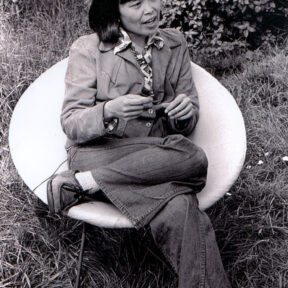
Wendy Yoshimura
: Photo from Creative Commons / Author of Photo: Nancy WongOverview
* Former Member of the Symbionese Liberation Army
Wendy Masako Yoshimura was born on January 17, 1943 at the Manzanar Internment Camp for Japanese Americans, where her parents were detained during World War II. After the war, the Yoshimura family relocated to the Japanese island of Etajima, where her father served as an interpreter for the British Occupation Forces. In 1956, the family settled in the Central Valley town of Sanger, near Fresno. Since she spoke only limited English, the 13-year-old Yoshimura was placed in the second grade. She eventually finished high school in 1963 and then attended Fresno City College for one year. Her parents subsequently sent her to the California College of Arts and Crafts, from which she graduated in 1969.
Yoshimura thereafter became involved with a radical group called the Revolutionary Army, which was founded by her boyfriend Willie Brandt. On March 30, 1972, police discovered a pipe bomb, various explosives in mid-construction, a machine gun, and numerous other weapons in a Berkeley, California garage that Yoshimura had rented under an assumed name. Yoshimura’s fingerprints were found on the aforementioned items, as well as on a book about forming an urban guerrilla unit, and on an Army training manual for the use of rifles and rocket launchers. Police also found notes and letters discussing plans to bomb the Naval architecture building and other targets on the UC Berkeley campus. Brandt, Michael Bortin and Paul Rubenstein were arrested for their roles in these conspiracies on March 31, 1972 and were eventually convicted, but Yoshimura evaded police and lived under an alias in New Jersey until 1974.
Also in ’74, Yoshimura joined the Symbionese Liberation Army (SLA), a pro-Marxist, California-based terrorist group that sought to overthrow the U.S. government by means of guerrilla warfare. When the radical sports writer and activist Jack Scott helped SLA members William Harris, Emily Harris, and Patricia Hearst relocate to rural Pennsylvania in May of that year—shortly after six SLA members had been killed in a two-hour shootout with police in South Central Los Angeles—he further arranged for Yoshimura to join the SLA as an aide who would handle tasks like shopping and other public transactions for Hearst and the Harrises. It was during this period that Yoshimura’s friend Kathleen Soliah joined the SLA as well. Hearst later described Yoshimura as the group’s “explosives expert” who had taught other SLA members how to make pipe bombs.
On April 21, 1975, Yoshimura and Patricia Hearst drove the getaway cars for four SLA members—Emily Harris, Kathleen Soliah, Michael Bortin, and James Kilgore—who held up the Crocker National Bank in Carmichael, California, and also for their lookouts, William Harris and Steven Soliah (Kathleen’s brother). During the robbery, Emily Harris shot and killed a 42-year-old innocent bystander named Myrna Opsahl, who was a church secretary and the mother of four children.
In September 1975, Yoshimura was arrested in an SLA hideout in San Francisco for illegal possession of explosives in connection to the 1972 Berkeley garage case. Also arrested for various offenses were Patricia Hearst, William Harris, and Emily Harris. Among the items which FBI investigators subsequently found in the hideout was a letter that Yoshimura had recently written (but never mailed) to her former boyfriend Willie Brandt, a letter whose contents proved conclusively that Yoshimura was deeply involved with, and committed to, the SLA.[1] Eventually, Yoshimura was sent to state prison for six months and was paroled in 1980.
Meanwhile, the Myrna Opsahl murder case languished for years as prosecutors did not believe that they had enough evidence to convict Yoshimura and her SLA comrades—because the perpetrators wore masks during the Crocker National Bank robbery and thus could not be definitively identified. In 1990 Yoshimura was granted limited immunity to testify (vis a vis Opsahl) against her former cohorts in a Sacramento County grand jury investigation. The prosecutor, John O’Mara, showed Yoshimura photographs of Mrs. Opsahl’s blood on the bank floor, hoping “to jar her [Yoshimura] emotionally, to appeal to a higher sense within her, some sympathy for this poor woman [Opsahl] who happened to be in the wrong place at the wrong time.” But in her testimony, Yoshimura denied having known that she was participating in a bank robbery and claimed that she could not remember anyone involved in the crime other than Hearst. The judge cited Yoshimura for contempt of court.
For almost twelve more years thereafter, Mrs. Opsahl’s son Jon relentlessly continued to pressure political and law-enforcement authorities to bring his mother’s killers to justice. His persistence finally paid off on January 16, 2002, when newly uncovered evidence—derived from groundbreaking forensic technology that now enabled the FBI to link shotgun shells removed from the victim’s body to those that had been found in an SLA hideout—made it possible for murder charges to be brought against Sara Jane Olson (Kathleen Soliah), William Harris, Emily Montague (formerly Emily Harris), and Michael Bortin.
Today Yoshimura is a watercolor artist and painting instructor who lives in Oakland, California.
Further Reading: “Wendy Yoshimura Emerges from the Shadows of the Patty Hearst Case” (People.com, 10-6-1975); “SLA’s Yoshimura Keeps Mum While Ex-Comrades Serve Time” (San Francisco Chronicle, 12-27-2003); “Timeline: Guerrilla: The Taking of Patty Hearst” (PBS.org); “Tania’s World: The Inside Story of the Patty Hearst Kidnapping, Part Two” (Rollong Stone, 11-20-1975); “What Is the Symbionese Liberation Army?” (Slate.com, 1-24-2002); “Notorious Alumni” (Inside.IDSNews.com, 2-16-2014); “Sara Jane Olson, Four Former SLA Members Charged in Deadly Bank Heist” (Fox News, 1-16-2002); “4 Former Radicals Are Charged In 1975 Killing in Bank Robbery” (NY Times, 1-17-2002).
Footnotes:
- McLellan, Vin, and Paul Avery, The Voices of Guns. The Definitive and Dramatic Story of the Twenty-Two Month Story of the Symbionese Liberation Army, G. P. Putnam’s Sons, 1977, pp. 481-483.